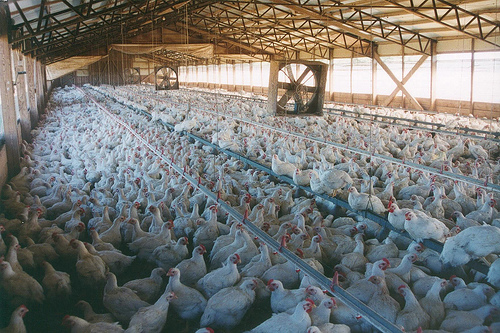Bloggers, this is an issue I can't take lightly. On one side of the debate, I have read about the science behind genetic modification and have come to understand the effects of that type of technology on biodiversity (the great force behind evolution in an ecosystem) and I am afraid for the long term effects it could have on the people who live off this food. In the short term, there are
925 million people starving right now, and genetic modification can dramatically
increase crop yields in developing countries. Maybe down the road this technology will have adverse effects on the environment; maybe genetically modified food does increase your risk of cancer over many years (the studies so far are inconclusive). That still means in some areas genetically modified organisms (GMOs) can make the difference between increasing your risk of developing cancer someday or increasing your risk of starving to death. I feel like it's important to consider that in this argument. That said, there still needs to be more testing and regulation on biotechnology, because the problems that scientists forsee for the future of industrial agriculture must be considered as well.
Since 1992, GMOs have been listed by the FDA under the category "
GRAS," Generally Recognized As Safe. GRAS substances require no testing of any kind before being sold, so the government's official stance towards patenting and selling biotech foods became a policy of no regulation, and since they are considered safe, you don't need to label genetically modified food or ingredients either. Most GRAS foods become so after exhaustive experimentation, including replication, that proves their safety; GMOs managed to make the cut after testing that proved GMOs need more testing:
“The processes of genetic engineering and traditional breeding are different and according to the technical experts in the agency, they lead to different risks.”
-FDA Internal memo, Jan. 8th 1992
Somewhere along the line, some dissenting voices got supressed, Michael Taylor, a representative from the biotechnology giant Monsanto got appointed Deputy Commissioner for the FDA, and GMOs became GRAS on May 26, 1992. Now they grow across 100,000,000 acres of US farmland.
What were the scientists worried about? In the area of human health, allergic reaction, nutritional decline, incidence of new diseases, and my personal favorite, from Dr. Charles Benbrook, the former director of the Board on Agriculture at the National Academy of Science: "The medical community is terrified about the loss of antibiotics...on a worldwide basis." When biotechnology companies go about genetically modifying plants, their main goal is to insert a gene that will produce a desired effect on the profitability of a crop, like round up ready seeds, created to survive being sprayed with the popular herbicide round up, or BT crops, engineered to produce their own insecticide. But, they also insert an antibiotic marker gene into the sequence, so they can test a sample of bacteria engineered to introduce these genes into a plant with that antibiotic, to test that the sequence is being transcribed and produced in the cells. So far, the tests on GMOs and antibiotic resistance have been inconclusive-but of course, they no longer require that anyway. However, we do know that organisms like to reproduce. When they do that, their genes combine in unpredictable ways-just take a look at a picture of you and your parents if you want proof of that. The possibility for variation and propagation of these engineered mutations are a major concern the scientific community has about GMOs.
Environmentally, these new gene sequences are probably the number one threat to plant
biodiversity today. The cost of growing GMOs is lower for the farmer, because they can spray fewer pesticides (until the weeds develop a resistance to the sprays) and the government provides subsidies to people who farm certain crops. Namely, corn, soybeans, cotton, and canola-the most commonly genetically modified crops. So, people who want to make money, only grow what they can profit off, but it doesn't stop there. Because of cross-pollination, there have been many cases documented where farmers unknowingly end up growing GM crops like their neighbors. I call them "cases," because there actually are
court cases, hundreds of them, filed by Monsanto for patent infringement, but that's a story for another day. Anyway, what we get is the government paying farmers to flood the ecosystem with new, unregulated, unpredictable genes. A study conducted by Professor Ignacio H. Chapela from the University of California, Berkeley found GM gene sequences present in corn being grown all the way in Oaxaco, Mexico. Furthermore, this corn came from traditional land races, areas of farmland set aside in mexico to grow thousands of varieties of corn native to Mexico. These farmers were not using genetically modified seeds. Whatever crops were contaminated was an unintentional, unavoidable effect of plants natural tendency to reproduce, sometimes across great distances.
Since the dawn of agriculture, humans have cultivated many thousands of species. In the last hundred years, 90% of food cultivated by farmers has come from 15 plants and 8 animals. That's a big change, in a very short period of time. Instead of growing a diverse selection of crops, farmers widely grow in monocultures now-large fields dedicated to one variety of crop. That's now the standard for raising GMOs, and all other factory farmed produce. These monocultures are ideal for promoting homogeneity in a species, which is what companies want to sell, but not what nature can support. Genetic uniformity increases the rate of predation on crops by insects and diseases. Remember the Irish potato famine? All those potatoes were the same variety, causing them all to be susceptible to the same disease, causing thousands of people to die. So, it is possible, genetically modified foods could one day be the cause world hunger, instead of the cure. It's food for thought. It's why we need more tests. It's why genetically modified foods should be labeled, so at least we can have a choice in supporting them.










